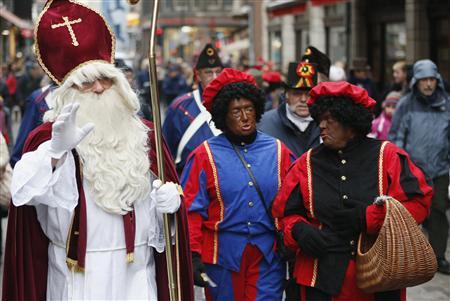The Christmas tradition of St Nicholas and his helper Black Pete is under threat in the Low Countries as protestors claim it is “racist”, according to reports from AFP.
Stories retold over the centuries tell of Sinterklaas, the former Bishop of Turkey, who lands in The Netherlands ahead of his Saint’s Day on the 6th December.
The arrival by boat takes place towards the end of November where Zwarte Piet (Black Pete) follows St Nicholas – who is dressed in religious clothing – and hands out sweets to the children who gather to see his arrival.
For children, the excitement of the arrival of ‘Sinterklaas’ includes the joy surrounding his helper who is loved by the children and an integral part of the story.
But over the last few years there have been an increase in the protests against this Dutch and Flemish tradition which resulted in 60 people being arrested on Saturday in the city of Gouda.
“There were 60 arrests on both sides” a Gouda police spokesman told AFP, mainly from people who had gathered in the wrong area.
The state broadcaster NOS showed images of fights breaking out on the streets at the festival, which is aimed at a young audience.
Most people were detained for protesting in unauthorised places, and at least one person resisted arrest, the police reported.
There are a few explanations about Zwarte Piet, the main tale being that because St Nicholas lives in Madrid his helper was a Moorish Spaniard. The other, which descends from older Germanic tales, is that his helper is black because of the soot from chimneys where he listened to determine whether the children listening had been good or bad. Much older stories have his helpers as two black ravens, who also listen at chimneys – but there is no mention of Black Pete being from a former Dutch colony or a slave.
If children had been well behaved they could expect to find small presents and sweets in the shoes they left by the fire the night before. If they had been bad, they were risking a birching or even being taken back to Madrid in a sack.
A survey in 2013 for the Telegraaf showed 92 percent of the Dutch public don’t perceive Zwarte Piet as racist or associate him with slavery, and 91 percent are opposed to altering the character’s appearance.
The Belgians have also taken a firm line on preserving the tradition, with the Centre for Equal Opportunities and Opposition to Racism clearly stating that the character is non-discriminatory.
Earlier this year, Amsterdam’s regional court said the image of Black Pete “with his thick red lips, being a stupid servant, gives rise to a negative stereotyping of black people” and ordered the authorities to review the festival. Previously several people acting under the auspices of the UN told the Government of the Netherlands to investigate the allegations which the UN later dropped and assured the Dutch that their Sinterklaas traditions would not be investigated for ‘racism’. Marc Jacobs, a Belgian Unesco representative, stated that the person who had signed the letter to the Dutch government, Jamaican Verene Shepherd, had no authorisation to do so.
Black Pete’s defenders say he is black from coming down the chimney, pointing out that soot is black and chimney sweeps often had black, sooty faces, and refuse to admit there might be anything racist about the historic character.
For most Dutch people, covering faces with dark make up is not racist but simply part of dressing up and getting into character the same as a clean shaven, thin man would put on a beard and a belly to play the English version of Santa Claus.
One former resident of The Netherlands told Breitbart London, “Most Dutch don’t consider it racist, and the point of him is that he’s black, so unless you’re black you have to put black make up on! It’s just accepted.”
This year Saint Nicholas arrived in Gouda aboard a gift-filled boat from Spain joined by not only Zwarte Piet but many other different coloured Petes, introduced by the mayor.
They include ‘Cheese Petes’ with yellow faces, ‘Stroopwafel Petes’ with striped, light brown faces resembling the traditional Dutch toffee waffle of the same name and a white-faced ‘Clown Pete’.
But protestors still tried to disrupt the annual celebration by wearing t-shirts saying ‘Black Pete Colonial Symbol’ or ‘Black Pete Doesn’t Fit’.
There have been previous attempts to bow to those claiming the traditional depiction is racist. In 2006 the Dutch broadcaster NTR replaced Zwarte Piet with rainbow-coloured Peter. This resulted in much criticism from Dutch viewers.
In December 2011 a celebration in New Westminster, British Columbia was cancelled following a debate about the inclusion of the character.
A spokesman explained this decision, saying: “We got a lot of replies back from our customers in the Dutch community. It became pretty clear to us that we love Sinterklaas and we can’t have it without Black Peter. Those two go together.”
This weekend, St Nicholas himself was even embroiled in the debate, with protestors unfurling a large banner reading “Black Pete Racism” when he appeared on the balcony overlooking the main square.
At a press conference after the procession, Saint Nicholas was asked if he had followed the Black Pete debate.
“It will all work itself out,” Saint Nicholas said. “Nobody should be worried.”

COMMENTS
Please let us know if you're having issues with commenting.